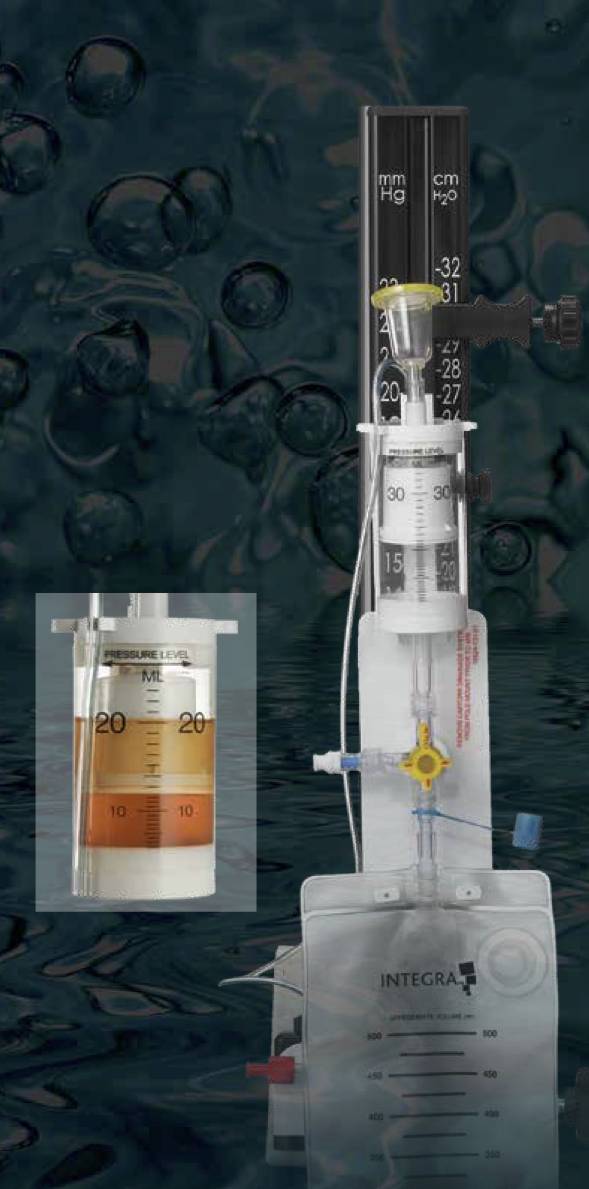The LimiTorr™ Volume Limiting External CSF Drainage and Monitoring System is used for drainage of Cerebrospinal Fluid (CSF) from a ventricular or lumbar catheter. LimiTorr a volume limiting valve mechanism which reduces the chance of excessive CSF drainage by halting drainage when the pre-determined volume (20 mL or 30mL) is reached.
- Antimicrobial hydrophobic filter allows venting even if wet.
- Stable and secure transducer connection.
- Needleless sampling sites marked with yellow labels for easy identification.
- Green striped pressure tubing on patient line.
Part Number: INS9020, INS9030
Catalog Order Number:
INS-9020: 20mL LimiTorr Volume Limiting External CSF Drainage and Monitoring System
INS-9030: 30 mL LimiTorr Volume Limiting External CSF Drainage and Monitoring System
INS-2101: External CSF Drainage System Replacement Bag with Anti Reflux Valve and Blue Cap (Sold Individually)
INS-400: Evolution Pole Mount Assembly with cmH2O and mmHg Rail for mounting the LimiTorr System
Indications:
The LimiTorr system allows for drainage and monitoring of CSF from the lateral ventricles of the brain or the lumbar subarachnoid space in selected patients to reduce intracranial pressure (ICP), to monitor CSF, to provide temporary drainage of CSF in patients with infected CSF shunts, and to monitor ICP.
Contradictions:
This device is not designed, sold, or intended for use except as indicated. ICP monitoring and external CSF drainage is contraindicated in the following: anticoagulation therapy and coagulation disorders. System use is contraindicated where trained personnel are not available to supervise drainage and monitoring on a 24 hour a day basis. Catheter placement is contraindicated in the presence of infections in the surrounding area including scalp skin, subcutaneous tissue, bone and epidural space. The use of a lumbar catheter for drainage is contraindicated for patients with non-communicating hydrocephalus, where lumbar puncture is contraindicated, in the presence of a large intracranial mass, lesion, tumor, hematoma or cyst, with demonstrated blockage of CSF to the subarachnoid space due to trauma, tumor, hematoma or other large mass, and in cases of spinal abnormalities that prevent insertion of a catheter.
Warnings:
Patients connected to a cerebrospinal fluid drainage system must be observed for signs and symptoms of changing intracranial pressure. These signs and symptoms may vary from patient to patient. Increased intracranial pressure may be characterized by, but not limited to, headache, drowsiness, other signs of deterioration of consciousness and nuchal rigidity. In an infant, increased scalp tension at the anterior fontanelle and congestion of scalp veins may be noted. Failure to adjust the rate of CSF outflow through the external drainage system may result in potentially serious injury to the patient. Improper drainage system set-up can lead to overdrainage or underdrainage and potentially serious injury to the patient. In order to minimize the possibility of infection, meningitits, or ventriculitis, the sampling site should be cleaned according to hospital protocol prior to use. A 70% Isopropyl Alcohol solution is compatible with the sampling site. Strict aseptic technique should be used, at all stages of utilization and maintenance, and any time the system must be accessed, changed, or otherwise manipulated.
Precautions:
Inform the patient or their representative of possible complications associated with the use of this system. In order for the volume limiting valve to operate correctly; the lumbar drain must remain vertical. Do not insert needle into needless sampling site. System is not reusable. If system is dropped, the volume limiting valve mechanism may be damaged and should be discarded. Use of needle will damage needleless sampling site. Sterile technique should be observed in preparing the system, connection of the catheter, replacement of the drain bag, and accessing the system. All sampling sites should be cleaned per hospital protocol. Do not use device on an IV Pole or INS 400 series Pole Mount that has been damaged and is not capable of a consistent vertical position. If pressure monitoring includes the use of transducers, all personnel should be familiar with the instructions from the manufacturer for proper calibration and performance. While the filter is hydrophobic, prolonged contact longer than 30 minutes with CSF may compromise its function. When transporting patient, empty burette into drainage bag and turn patient line stopcock off to prevent CSF drainage to burette. If CSF has migrated into hydrophobic filter, open the stopcock between burette and drainage bag to drain antimicrobial hydrophobic vent. The system must be securely attached in a vertical position to an Integra Pole Mount Assembly (INS 400 series). All luer connections must be checked during priming of the system and prior to connecting to the patient. Ensure that all connections are secure and leak free. Integra makes no claim for or representation as to the performance characteristics of this product if it is used in conjunction with components of other manufacturers.









